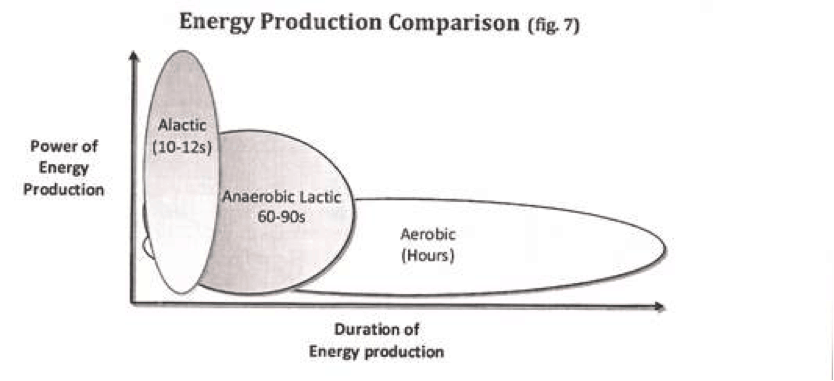Introduction
Join us on the last leg of our journey into the core energy systems of the human body.
Today, we focus on a significant yet often overlooked facet of our physiological functioning – the anaerobic lactic energy system.
Table of Contents
Despite its critical role in peak athletic performance and high-intensity training, this energy system tends to be less understood and often underutilized in training regimens.
As fitness professionals, gaining a thorough understanding of this unique system, its functions, and its potential for impacting client performance can significantly enhance your coaching strategies.
This guide provides an in-depth look at the anaerobic lactic system, its place in the energy system hierarchy, and expert advice on incorporating it effectively into your clients’ training routines – when they are ready.
If you haven’t had the chance to peruse our previous discussions on the Aerobic Energy System and the Anaerobic Alactic Energy System, we highly recommend doing so.
These comprehensive articles set the groundwork for appreciating the role and intricacies of the anaerobic lactic system in our clients’ fitness journeys.
Our client’s physical abilities hinge significantly on their energy systems. While humans are fundamentally aerobic beings, the anaerobic energy systems, namely the alactic and lactic systems, can greatly augment their athletic performance.
However, these systems should not be approached lightly. Clients must first establish a robust aerobic base and achieve a level of physical strength sufficient for deep neural engagement before progressing into anaerobic training.
Although our focus often remains on the aerobic energy system for its foundational role in fitness, an expertly timed and well-structured progression into the anaerobic lactic system can unlock a new level of performance for our clients.
This comprehensive guide provides you with the knowledge and strategies necessary to safely and effectively facilitate this progression.
The Three Energy Systems (Re-Cap)
As a quick reminder, there are three energy systems. The body draws on all three, regardless of the type of effort you put in. They merely vary in the amount of energy they contribute, depending on the duration and intensity of the effort.
They are the ATP-PC System or Alactic System, the Anaerobic Glycolysis or Lactic Acid Sytem, and the Aerobic system. ATP (Adenosine tri-phosphate) is the only energy source for all bodily functions and movements. When ATP is used for energy production, it must be replenished.
The body can replenish ATP aerobically or anaerobically. The Aerobic System replenishes ATP with the presence of oxygen. The Alactic and Lactic Systems replenish ATP without the presence of oxygen.
In terms of working time frames, we’re looking at:
- Alactic = Activities < 10 Seconds
- Lactic = Activities lasting approximately 40–90 seconds
- Aerobic = Activities lasting hours
Alternatively, the visual below might help you have a better understanding.

What Is the Anaerobic Lactic Energy System?
I don’t think I’ve known anyone describe the lactic energy system better than James Fitzgerald of OPEX Fitness. He refers to this as “pain,” and more appropriately, the #ShittyShitShit area of fitness.
For me, that hashtag sums it up perfectly. However, for those looking for a more scientific explanation, keep reading.
The lactic energy system operates by using glycogen and lactate as fuel for intense activity. It starts working once the alactic system has been depleted.
For the purpose of definition and guidelines, it’s for activities lasting approximately 40–90 seconds. It kicks in once the alactic stores have been depleted.
Alactic means “without the presence of lactate.” Lactate is the by-product of intense work, which can be present in the blood, muscles, and throughout the body. Lactic means “with the presence of lactate.”
The body prefers to generate most of its energy using aerobic methods, meaning with oxygen. However, some circumstances require energy production faster than our bodies can adequately deliver oxygen.
In those cases, the working muscles generate energy anaerobically. This energy comes from glucose through a process called glycolysis, in which glucose is broken down or metabolized into a substance called pyruvate through a series of steps.
When the body has plenty of oxygen, pyruvate is shuttled to an aerobic pathway to be further broken down for more energy. But when oxygen is limited, the body temporarily converts pyruvate into a substance called lactate, which allows glucose breakdown—and thus energy production—to continue.
The working muscle cells can continue this type of anaerobic energy production at high rates for one to three minutes, during which time lactate can accumulate to high levels.
A side effect of high lactate levels is an increase in the acidity of the muscle cells, along with disruptions of other metabolites. The same metabolic pathways that permit the breakdown of glucose to energy perform poorly in this acidic environment.
On the surface, it seems counterproductive that a working muscle would produce something that would slow its capacity for more work.
In reality, this is a natural defense mechanism for the body. It prevents permanent damage during extreme exertion by slowing the key systems needed to maintain muscle contraction.
Once the body slows down, oxygen becomes available and lactate reverts to pyruvate, allowing continued aerobic metabolism and energy for the body’s recovery from the strenuous event.
The production of lactate and other metabolites during extreme exertion results in the burning sensation often felt in active muscles.
This often painful sensation gets us to stop overworking the body, thus forcing a recovery period in which the body clears the lactate and other metabolites.
For the sake of simplicity, you can think of anaerobic lactic training as power endurance.
Lactic energy system training is an unsustainable energy pathway.
It is only effective for the right person, at the right time, and this person must have the pre-requisite strength and aerobic capacity to perform this type of work.
It is a horrendous ordeal, and it’s only for people who have earned the right to train it.
Alactic is terminology for being without the presence of lactate. Lactate is the by-product of intense work, which can be present in the blood, muscles, and throughout the body. Lactic is with the presence of lactate. The time frames given for alactic and lactic work are given for broad classification purposes
Contrary to popular HIIT belief, 90% of the world’s population should not be training in this energy system.
It is an unsustainable method of energy production, and it is only useful in the context of survival or sports. Most individuals are already living in a “survival” state: stress, life, kids, work, and as tempting as it is to utilize this type of training for people who have a limited amount of time, it’s ineffective for their overall health and longevity.
If we insist on lactic energy training for these everyday athletes, it can result in more fatigue for these individuals, who simply do not have the base of support for it thus taking them farther away from their goals.
There are professions and sports in which people do need to train this energy system. It is extremely important to be aware of it and know how to train it effectively.
However, a master craftsman knows how to pick the right tool, for the right time. Such is the case here for the Alactic energy system.
There are essentially three main reasons for training the lactic energy system.
- It creates a stress adaptation for athletes,
- it creates a metabolic adaptation, and
- it acts as a booster for the aerobic energy system that allows athletes to sustain top-end power for longer periods of time.
To elicit the correct dose response from anaerobic lactic training, you need to be able to dig deep into your central nervous system. This only comes with significant pre-requisite strength and aerobic capacity.
As a reminder of our baseline standards, here are our minimum strength standards that must be met prior to training alactic power AND now lactic power:
Women
- 1.25 x bodyweight deadlift x 5 reps
- Bodyweight back squat x 5 reps
- 3 x pull-ups
- 3 x dips
- 75% bodyweight farmers carry – 90 seconds
Men
- 1.5 x bodyweight deadlift x 5 reps
- Bodyweight back squat x 5 reps
- 5 x pull-ups
- 5 x dips
- 75% bodyweight farmers carry – 90 seconds
In addition to these strength standards, each everyday athlete must have demonstrated adequate aerobic capacity AND progressed through our alactic power protocols.
You simply have to earn the right to train the lactic energy system.

How Do We Train the Lactic Energy System?
Once again, we can open up a can of worms diving into this. The honest answer is, it varies.
It varies from person to person, and it all comes down to the individual’s assessments. We do know that we need ask the following questions:
- Are they strong enough? Yes/No
- Do they have a good foundation in aerobic training? Yes/No
- Have they progressed through the alactic training principles? Yes/No
- Is this applicable in their life right now? Yes/No
If the answer is yes to all of the questions above and the needs of the client dictate that we do anaerobic lactic work, then do we do it.
As a reminder, most people simply do not need to do this type of anaerobic work. It is unsustainable and puts the body into survival mode.
We do not need to stress the average person out even more than they already are. It plays havoc with their body and will certainly not help them reach their goals any faster. In fact, it often has the opposite effect.
When working the anaerobic continuum, we progress from power to endurance. That’s our default model. The aerobic continuum is the opposite way around, endurance to power.
Similar to developing the aerobic system, we look for repeatability in sets. This is key to developing the anaerobic system. We wait to flirt with failure but avoid burnout. That’s the secret.
The lactic energy system is far more complex than the alactic system. We start with 40–60 seconds of work, and then, over time increase it to a near-threshold of four minutes before it gets too aerobic.
This can be done through cyclical methods (assault bike, rower, etc.), or as the time frame increases, mixed modal. This means a combination of cyclical, bodyweight and weight training.
A Sample Anaerobic Lactic Power Session Would Be:
- Assault bike: max calories in 60 seconds
- Rest
- Repeat
- Can you hit the same number of calories in 60 seconds? Yes/No?
If yes, repeat. Continue until failure.
If no, you’re done for the day.
Over time, we’re looking to progress this to a higher number of working sets, but it takes time and patience and working in conjunction with your central nervous system.
We’re avoiding burn out at all costs. Why? Because the brain has one function. Survival. Anaerobic work is unsustainable work, and the brain doesn’t like it.
Final Thoughts
The anaerobic lactic energy system is an extremely important energy system, like the other two systems. We may prioritize the aerobic system and alactic systems first for health and longevity, but we certainly do not forget or underestimate the importance of the lactic system for the right people and the right athletes.
When programming for everyday athletes, 90% of them do not need to enter this type of energy system training. It’s survival-based training, and they simply do not need it to help them reach their true physical potential.
In order to train this energy system you first have to progress through alactic power work. This can take years in most cases. And again, we only start developing alactic power and move into lactic power when someone demonstrates the pre-requisite strength and has sufficiently progressed through the aerobic continuum.
There’s an art and a science to energy system training. I hope you can put what you’ve learned to good use.

